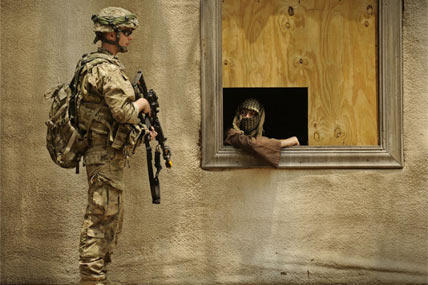After years of testing, Army uniform officials are planning to recommend that MultiCam should replace today's pixilated design as the official camouflage pattern the service issues to all soldiers, Military.com has learned.
Made by Crye Precision LLC of Brooklyn, N.Y., MultiCam is the pattern that outperformed the service's Universal Camouflage Pattern, or UCP, to become the Army's pattern for soldiers deploying to Afghanistan. UCP was nonetheless adopted in 2004, but came under congressional scrutiny when soldiers complained about its poor performance in Afghanistan.
Army uniform experts and scientists have been evaluating a handful of patterns that emerged from the service's exhaustive Phase IV camouflage improvement effort.
Program Executive Office Soldier would not comment on future camouflage recommendations.
"The Phase IV patterns are undergoing field trials and the data from those trials will be taken to Army senior leadership for review," said PEO Soldier spokeswoman Debi Dawson in a June 28 "media alert." "This will be followed by a cost-benefit analysis to determine if the Army will adopt a new camouflage pattern."
But officials running the camouflage effort are now looking at two options to recommend to the service's senior leadership this fall.
One option would be to make MultiCam the Army's official camouflage pattern, sources tell Military.com.
The second option would be to make MultiCam the service's pattern for garrison and general deployment use, but also to have a family of approved camouflage patterns that could be issued for specific areas of the world.
Earlier this week, UCP came under fire again in a story by The Daily, an online news site, which quoted several Army scientists from Natick Soldier Systems Center, Mass., alleging that the Army selected UCP long before testing was complete.
It was the first time Natick officials have publically pointed the finger at PEO Soldier and Army leaders, charging that UCP cost taxpayers billions in uniforms and matching body armor, backpacks and other equipment.
Congressional officials said they were surprised to see Natick scientists quoted directly questioning the Army's decision to adopt the pattern.
"This is the first time I have seen or heard that," said one staffer in the office of Senate Armed Service Committee Chairman Sen. Carl Levin. "Obviously, we are very concerned about this."
But criticism of the UCP is nothing new. In fact, two Natick studies – one completed in 2009 and the other in 2006, showed that MultiCam outperformed UCP in multiple environments.
Then in June 2009, Pennsylvania's Democratic Rep. John Murtha, who was then chairman of the House Appropriations Subcommittee on Defense, got involved in camouflage issue. Murtha pushed the service to look for a better camouflage pattern after receiving complaints from sergeants about the UCP's poor performance in the war zone. Murtha died in 2010, but his directive prompted the Army to launch a multi-phase camouflage effort. Many patterns were evaluated in Afghanistan, but MultiCam was the clear winner for the country's multi-terrain environment.
Earlier this year, the Army awarded contracts to four vendors to make camouflage-patterned material for uniforms and equipment as a result of Phase IV of the service's camouflage improvement effort.
In addition to Crye Precision, ADS, Inc., teamed with Hyperstealth, Inc., of Virginia Beach, Va.; Brookwood Companies, Inc of New York; and Kryptek, Inc. of Fairbanks, Alaska were chosen.
In March, the Army decided to drop the fifth finalist -- which was a government pattern developed at Natick. The pattern was too similar to one of the industry submissions, which scored higher in the initial evaluation, uniform officials said.
Natick officials would not release details of its pattern, but experts say it was likely from the Scorpion effort, a pattern developed by Crye Precision that was very similar to MultiCam. So far Crye officials have refused to reveal details about the pattern selected for Army evaluation.
Each finalist submitted a family of camouflage patterns for desert, woodland, and transitional along with a single coordinated pattern for individual equipment such as body armor and load-bearing gear so soldiers wouldn't have to change their kit from one environment to the next.
It's still unclear whether soldier body armor and other equipment will be produced and fielded in a specific camouflage pattern or a solid color such as "coyote brown," a color that the Marine Corps adopted for all of its individual equipment.






























